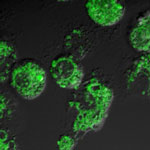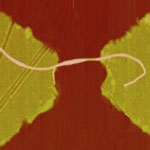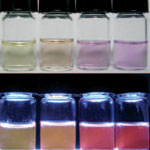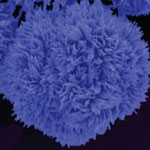Showing Spotlights 185 - 192 of 240 in category All (newest first):
 Environmental and behavioral factors may lead the body to produce superoxide radicals known as reactive oxygen species (ROS) that could cause cell damage through oxidation. Oxidative stress from ROS is implicated in aging and most diseases including cancer, heart disease, liver fibrosis, neurodegenerative diseases, autoimmune disorders. An excess of these reactive molecules can lead to oxidative stress and cellular damage, and toxicologists have identified ROS generation as a likely mechanism of nanoparticle toxicity. Since ROS plays an important role in various pathogenic processes, it has been recognized as an early indicator for cytotoxic events and cellular disorders. However, conventional chemical ROS probes have not fulfilled the rising need of in vitro and in vivo analysis of ROS generation due to auto-oxidation problems and poor specificity and sensitivity. Scientists in South Korea have now demonstrated a novel ROS-sensitive gold nanoprobe prepared from bio-inspired immobilization of fluorescein-labeled hyaluronic acid onto the surface of gold nanoparticles. This probe is highly stable under exposure to natural light and laser sources and extremely sensitive and specific to certain oxygen species.
Environmental and behavioral factors may lead the body to produce superoxide radicals known as reactive oxygen species (ROS) that could cause cell damage through oxidation. Oxidative stress from ROS is implicated in aging and most diseases including cancer, heart disease, liver fibrosis, neurodegenerative diseases, autoimmune disorders. An excess of these reactive molecules can lead to oxidative stress and cellular damage, and toxicologists have identified ROS generation as a likely mechanism of nanoparticle toxicity. Since ROS plays an important role in various pathogenic processes, it has been recognized as an early indicator for cytotoxic events and cellular disorders. However, conventional chemical ROS probes have not fulfilled the rising need of in vitro and in vivo analysis of ROS generation due to auto-oxidation problems and poor specificity and sensitivity. Scientists in South Korea have now demonstrated a novel ROS-sensitive gold nanoprobe prepared from bio-inspired immobilization of fluorescein-labeled hyaluronic acid onto the surface of gold nanoparticles. This probe is highly stable under exposure to natural light and laser sources and extremely sensitive and specific to certain oxygen species.
Jul 2nd, 2009
 Gas sensing applications are numerous in our modern society and include process monitoring, environmental compliance, health applications, homeland security, agriculture, etc. Gas sensors often operate by detecting the subtle changes that deposited gas molecules make in the way electricity moves through a surface layer. Thus, the more surface available, the more sensitive the sensor will be. Nanoscale materials are intriguing materials for next-generation nanotechnology gas sensors since their relative surface areas are so large. A problem with existing gas nanosensors is the cross-interference of other gas analytes. For instance, carbon nanotube based gas sensors for the prominent air pollutant nitrogen dioxide have shown strong interference of ethanol and ammonia gases to the NO2 response. Another cross-interference often is caused by humidity, i.e. the water vapor in the air. New research now demonstrates how the manufacturing of a nanosensor for ammonia gas can be tuned to eliminate the interference of water vapor. The trick lies in accurately controlling the synthesis of the sensing nanomaterial.
Gas sensing applications are numerous in our modern society and include process monitoring, environmental compliance, health applications, homeland security, agriculture, etc. Gas sensors often operate by detecting the subtle changes that deposited gas molecules make in the way electricity moves through a surface layer. Thus, the more surface available, the more sensitive the sensor will be. Nanoscale materials are intriguing materials for next-generation nanotechnology gas sensors since their relative surface areas are so large. A problem with existing gas nanosensors is the cross-interference of other gas analytes. For instance, carbon nanotube based gas sensors for the prominent air pollutant nitrogen dioxide have shown strong interference of ethanol and ammonia gases to the NO2 response. Another cross-interference often is caused by humidity, i.e. the water vapor in the air. New research now demonstrates how the manufacturing of a nanosensor for ammonia gas can be tuned to eliminate the interference of water vapor. The trick lies in accurately controlling the synthesis of the sensing nanomaterial.
Jun 23rd, 2009
 Infrared (IR) detectors are used in imaging applications that include for instance medical diagnosis, environmental monitoring, space science, and security and military sensor devices. High-quality detectors require cryogenic cooling in order for the image not to be distorted by the detectors own radiation. This makes them expensive both to produce and to run. Although uncooled IR detectors are made, their resolution and image quality tend to be much lower than cooled detectors. It appears that carbon nanotubes (CNTs) could be used as novel IR detector material that would allow the fabrication of highly efficient detectors that do not require cooling. Researchers at Michigan State University have now, for the first time, experimentally demonstrated the design, manufacturing and experimental testing of an integrated nanoantenna concept for CNT based IR sensors.
Infrared (IR) detectors are used in imaging applications that include for instance medical diagnosis, environmental monitoring, space science, and security and military sensor devices. High-quality detectors require cryogenic cooling in order for the image not to be distorted by the detectors own radiation. This makes them expensive both to produce and to run. Although uncooled IR detectors are made, their resolution and image quality tend to be much lower than cooled detectors. It appears that carbon nanotubes (CNTs) could be used as novel IR detector material that would allow the fabrication of highly efficient detectors that do not require cooling. Researchers at Michigan State University have now, for the first time, experimentally demonstrated the design, manufacturing and experimental testing of an integrated nanoantenna concept for CNT based IR sensors.
Apr 22nd, 2009
 Over the past few years, scientists have taken advantage of the unique optical and other physical properties of metal nanoparticles to create a wide range of nanotechnology probes for electronic, optical, and microgravimetric transduction of different biomolecular recognition events. An interesting approach that was reported a couple of years ago deals with a technique that estimates the antioxidant power of certain food samples by measuring the generation and growth of gold nanoparticles. Researchers have built on these findings by developing a novel optical nanoprobe that can analyze the total reducing sugar content of samples. This technique could lead to the development of inexpensive and disposable optical nanoprobes that could find applications in a host of industrial, biomedical and clinical fields.
Over the past few years, scientists have taken advantage of the unique optical and other physical properties of metal nanoparticles to create a wide range of nanotechnology probes for electronic, optical, and microgravimetric transduction of different biomolecular recognition events. An interesting approach that was reported a couple of years ago deals with a technique that estimates the antioxidant power of certain food samples by measuring the generation and growth of gold nanoparticles. Researchers have built on these findings by developing a novel optical nanoprobe that can analyze the total reducing sugar content of samples. This technique could lead to the development of inexpensive and disposable optical nanoprobes that could find applications in a host of industrial, biomedical and clinical fields.
Mar 24th, 2009
 In physics, a plasmon is the quasi-particle resulting from the quantization of plasma oscillations just as photons and phonons are quantizations of light and sound waves, respectively. As the name indicates, surface plasmons are those plasmons that are confined to surfaces. The control of these surface plasmons has become increasingly attractive for optical signal processing, surface enhanced spectroscopy and sensor nanotechnology. The plasmonic properties of nanoparticles depend on various parameters such as their size or shape, and the refractive index of the environment. Surface plasmons form the basis of localized surface plasmon resonance (LSPR) sensing, which allows the detection of single molecules. Researchers have now demonstrated for the first time that the absorption and emission properties of few-atom metal nanoclusters respond dramatically to changes in the chemical environment.
In physics, a plasmon is the quasi-particle resulting from the quantization of plasma oscillations just as photons and phonons are quantizations of light and sound waves, respectively. As the name indicates, surface plasmons are those plasmons that are confined to surfaces. The control of these surface plasmons has become increasingly attractive for optical signal processing, surface enhanced spectroscopy and sensor nanotechnology. The plasmonic properties of nanoparticles depend on various parameters such as their size or shape, and the refractive index of the environment. Surface plasmons form the basis of localized surface plasmon resonance (LSPR) sensing, which allows the detection of single molecules. Researchers have now demonstrated for the first time that the absorption and emission properties of few-atom metal nanoclusters respond dramatically to changes in the chemical environment.
Mar 11th, 2009
 The thing with technology is that the science behind it isn't good or bad but the way it is used could make all the difference. There are plenty of examples throughout history. Military nanotechnology is a good present day example. And we don't even need to talk about the weird, far-out stuff like nanobots and the Casimir force. Take explosives. While on one side there is research going on to improve high explosives through nanoscale structuring, other research teams are putting a lot of effort into detecting ever smaller trace amounts of explosives and building the ultimate nanoscale bomb dog. A recent example has been demonstrated by scientists in China, who obtained organic super-nanostructures via a simple solution process, and, for the first time, demonstrated that such structures can be applied as chemosensors to detect explosives.
The thing with technology is that the science behind it isn't good or bad but the way it is used could make all the difference. There are plenty of examples throughout history. Military nanotechnology is a good present day example. And we don't even need to talk about the weird, far-out stuff like nanobots and the Casimir force. Take explosives. While on one side there is research going on to improve high explosives through nanoscale structuring, other research teams are putting a lot of effort into detecting ever smaller trace amounts of explosives and building the ultimate nanoscale bomb dog. A recent example has been demonstrated by scientists in China, who obtained organic super-nanostructures via a simple solution process, and, for the first time, demonstrated that such structures can be applied as chemosensors to detect explosives.
Jan 16th, 2009
 Scintillation - a flash of light, lasting only nanoseconds to microseconds, produced in a particular material when it absorbs ionizing radiation - is one of the main methods used for the detection of ionizing radiation. Scintillators are very versatile and can be used for detecting almost all types of radiation in a wide range of energy from several electron volts (eV) to tens of billion of electron volts (GeV). Scintillation is useful for sensing alpha, beta and gamma radiation as well as other nuclear particles and in some cases determining the particle type. For example, organic scintillators can sense fast neutrons emitted spontaneously from fissile isotopes of uranium and plutonium, enabling passive detection of nuclear weapons. The detection and identification of subatomic particles is not only important for nuclear nonproliferation efforts but is a wide-ranging scientific problem with implications for medical devices, radiography, biochemical analysis, particle physics, and even astrophysics. Scientists from the Sandia National Laboratories in California have now proposed that metal-organic frameworks (MOFs) could potentially offer the desired level of structural control, leading to an entirely new class of radiation detection materials.
Scintillation - a flash of light, lasting only nanoseconds to microseconds, produced in a particular material when it absorbs ionizing radiation - is one of the main methods used for the detection of ionizing radiation. Scintillators are very versatile and can be used for detecting almost all types of radiation in a wide range of energy from several electron volts (eV) to tens of billion of electron volts (GeV). Scintillation is useful for sensing alpha, beta and gamma radiation as well as other nuclear particles and in some cases determining the particle type. For example, organic scintillators can sense fast neutrons emitted spontaneously from fissile isotopes of uranium and plutonium, enabling passive detection of nuclear weapons. The detection and identification of subatomic particles is not only important for nuclear nonproliferation efforts but is a wide-ranging scientific problem with implications for medical devices, radiography, biochemical analysis, particle physics, and even astrophysics. Scientists from the Sandia National Laboratories in California have now proposed that metal-organic frameworks (MOFs) could potentially offer the desired level of structural control, leading to an entirely new class of radiation detection materials.
Jan 14th, 2009
 Olfaction, our sense of smell, depends on the capability of specialized sensory cells in the nose to detect airborne odorant molecules. These olfactory cells contain specific protein molecules that acts as 'olfactory receptors' - they bind only to specific odorant molecules present in the air inhaled through the nose. When such a binding event occurs, the olfactory receptors change their shape and this deformation triggers chemical and electrical signals which are eventually transmitted to the brain through neurons. So, in a nutshell, this is how we smell. Human and especially some animal noses (think bomb-sniffing dogs) are very sophisticated and extremely sensitive gas sensors that can distinguish between very similar gas molecules. Researchers have been trying for a while to replicate the human olfactory sense - a concept called electronic nose (e-nose). While most nanotechnology-based efforts have focused on nanowires, new research conducted in Korea has demonstrated the detection of specific odorant molecules with a single-carbon-atomic resolution using a human olfactory receptor-functionalized carbon nanotube based sensor.
Olfaction, our sense of smell, depends on the capability of specialized sensory cells in the nose to detect airborne odorant molecules. These olfactory cells contain specific protein molecules that acts as 'olfactory receptors' - they bind only to specific odorant molecules present in the air inhaled through the nose. When such a binding event occurs, the olfactory receptors change their shape and this deformation triggers chemical and electrical signals which are eventually transmitted to the brain through neurons. So, in a nutshell, this is how we smell. Human and especially some animal noses (think bomb-sniffing dogs) are very sophisticated and extremely sensitive gas sensors that can distinguish between very similar gas molecules. Researchers have been trying for a while to replicate the human olfactory sense - a concept called electronic nose (e-nose). While most nanotechnology-based efforts have focused on nanowires, new research conducted in Korea has demonstrated the detection of specific odorant molecules with a single-carbon-atomic resolution using a human olfactory receptor-functionalized carbon nanotube based sensor.
Jan 8th, 2009
 Environmental and behavioral factors may lead the body to produce superoxide radicals known as reactive oxygen species (ROS) that could cause cell damage through oxidation. Oxidative stress from ROS is implicated in aging and most diseases including cancer, heart disease, liver fibrosis, neurodegenerative diseases, autoimmune disorders. An excess of these reactive molecules can lead to oxidative stress and cellular damage, and toxicologists have identified ROS generation as a likely mechanism of nanoparticle toxicity. Since ROS plays an important role in various pathogenic processes, it has been recognized as an early indicator for cytotoxic events and cellular disorders. However, conventional chemical ROS probes have not fulfilled the rising need of in vitro and in vivo analysis of ROS generation due to auto-oxidation problems and poor specificity and sensitivity. Scientists in South Korea have now demonstrated a novel ROS-sensitive gold nanoprobe prepared from bio-inspired immobilization of fluorescein-labeled hyaluronic acid onto the surface of gold nanoparticles. This probe is highly stable under exposure to natural light and laser sources and extremely sensitive and specific to certain oxygen species.
Environmental and behavioral factors may lead the body to produce superoxide radicals known as reactive oxygen species (ROS) that could cause cell damage through oxidation. Oxidative stress from ROS is implicated in aging and most diseases including cancer, heart disease, liver fibrosis, neurodegenerative diseases, autoimmune disorders. An excess of these reactive molecules can lead to oxidative stress and cellular damage, and toxicologists have identified ROS generation as a likely mechanism of nanoparticle toxicity. Since ROS plays an important role in various pathogenic processes, it has been recognized as an early indicator for cytotoxic events and cellular disorders. However, conventional chemical ROS probes have not fulfilled the rising need of in vitro and in vivo analysis of ROS generation due to auto-oxidation problems and poor specificity and sensitivity. Scientists in South Korea have now demonstrated a novel ROS-sensitive gold nanoprobe prepared from bio-inspired immobilization of fluorescein-labeled hyaluronic acid onto the surface of gold nanoparticles. This probe is highly stable under exposure to natural light and laser sources and extremely sensitive and specific to certain oxygen species.
 Subscribe to our Nanotechnology Spotlight feed
Subscribe to our Nanotechnology Spotlight feed





